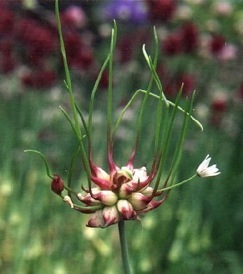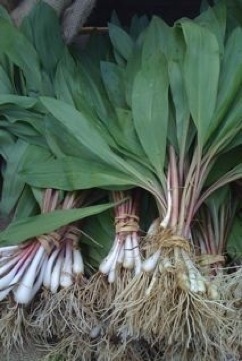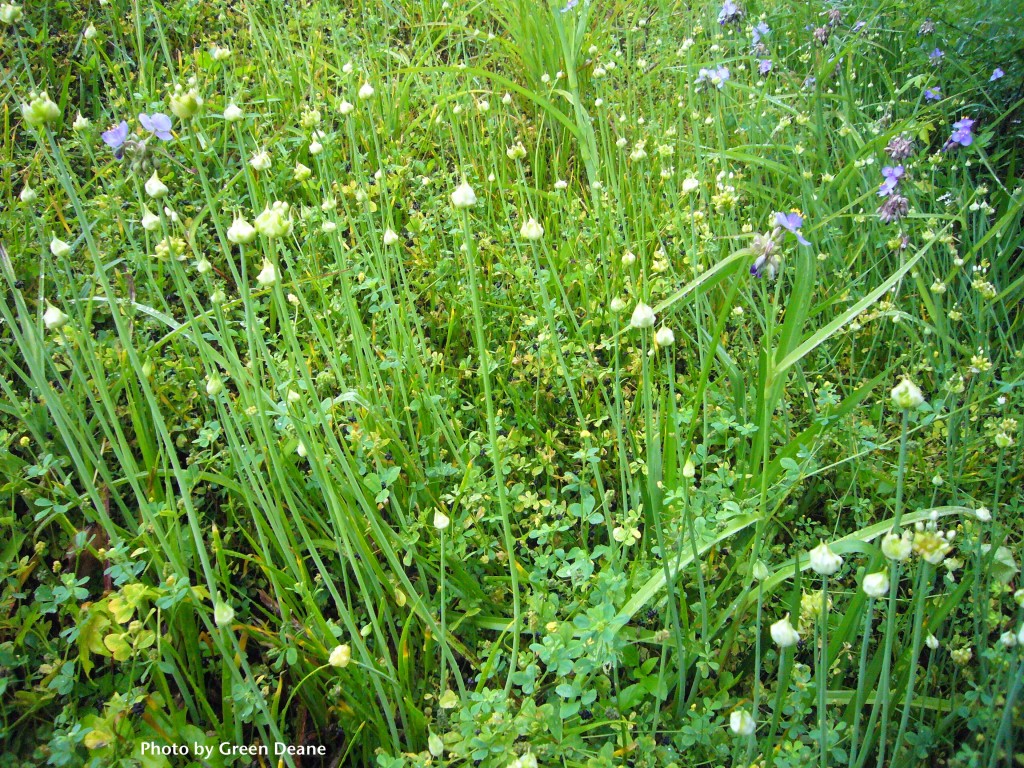Allium canadense: The Stinking Rose
Your nose will definitely help you confirm that you have found wild onions, Allium canadense, AL-ee-um kan-uh-DEN-see. Also called Wild Garlic and Meadow Garlic by the USDA, walking through a patch raises a familiar aroma which brings me to a foraging maxim:

Wild onions/garlic, set bulblets on top
If a plant looks like an onion and smells like an onion you can eat it. If a plant looks like a garlic and smells like a garlic you can eat it. If you do not smell a garlic or an onion odor but you have the right look beware you might have a similar-looking toxic plant. For example, we have a native lily here in Florida that looks like an onion but has no aroma. It is toxic.
All parts of this particular Wild Onion/Garlic are edible, the underground bulbs, the long, thin leaves, the blossoms, and the bulblets on top. The bulblets are small cloves the plant sets where it blossoms. Harvesting them is a little easier than digging for bulbs but those are easy to find also. They’re usually about four inches underground. The bulblets are on the tippy top of the plant. It’s called both an onion and garlic because while it is a wild onion it has a very strong garlic aroma.
Onions and garlic belong to the Lily family. The most common wild one is the Allium canadense. It has flattened leaves and hollow stems. On top there can be bulblets with pinkish white flowers or bulblets with sprouted green tails. When it sets an underground bulbs they will be no bigger than pearl onions. (See recipes below the I.T.E.M. panel.) They were clearly on the Native American menu though our local natives didn’t refer to them much.

Ramps have wide leaves
It is often said the city of Chicago’s name is from an Indian phrase that means “where the wild onions grow.” That is quite inaccurate. Chicago is actually a French mistransliteration of the Menomini phrase Sikaakwa which literally means “striped skunk.” We would say ‘the striped skunk place.” The skunks were there because Allium tricoccum (Ramps) were growing there. Skunks know good food when they smell it (and are bright pets. Very common where I grew up.) The nearby Des Plains River was called the “Striped Skunk River.” Incidentally because of man’s intervention that river now flows backwards from it original direction.
While northern Indians used the Allium species extensively there are few records of southeastern Indians using them, though various southern tribes had names for the onion. Some of the tribes considered onions not edible. Ramps, A. tricoccum, (try-KOK-um) photo upper right, are also in the onion family, and very common in Appalachia. Farther north they are called “wild leeks.” Unlike onions and garlic, ramps have wide leaves but are used the same way.
Allium was the Latin name for the onion. An alternative view is that it is based on the Celtic word “all” meaning pungent. “Alla” in Celtic means feiry. Canadense means of Canada, but refers to north North America. Tricoccum means three seeds. Roman’s called garlic the “stinking rose.”
Allium canadense in large amounts can be toxic to cattle. Lesser amounts can flavor the milk as can salty fodder near the ocean.
Green Deane’s “Itemized” Plant Profile: Wild Onion
IDENTIFICATION: Allium canadense: Grass like basal leaves, small six-petaled flowers, odor of onion or garlic, stems round, older stems hollow. Underground bulbs look like small white onions. Ramps, however, have two or three broad, smooth, light green, onion-scented leaves. Also see another article on a European import, the dreaded Garlic Mustard.
TIME OF YEAR: Depends where you live. Ramps in spring, onions through the summer, bulbs in fall. Locally we see bulblets in April then into the spring.
ENVIRONMENT: Like most plants onions like rich soil and sun but can grow in poor soil with adequate water. Leeks like rich leaf-losing woodlands and can grow in dappled shade. Locally all of the Wild Onions I’ve seen grow in damp places, or, places where run off gathers before seeping in.
METHOD OF PREPARATION: The entire plant is edible raw or cooked, in salads, seasoning, green, soup base, pickled. You can pickle them using red bay leaves, peppergrass seeds, and some vinegar
Recipes adapted from “Wild Greens and Salads” by Christopher Nyerges
Onion Soup On The Trail
Two cups onion leaves and bulbs
Two cups water or milk (or from powdered milk)
1/4 cup chia seeds (optional) or grass seed
four bottom end tips of cattails
A Jerusalem artichoke
Two table spoons acorn flour (or other flour)
1.4 cup water
Put chopped onions in 1/4 water and boil for five minutes. Add the rest of the liquid, cattail and Jerusalem artichoke. Cook at low temperature. Do NOT boil. When artichoke is almost done add flour and chia seeds. Mix. Salt and pepper to taste. Serves three.
Camp Salad
One cup onion leaves and bulbs
1/2 cup Poor Man’s Pepper Grass or Mustard leaves
One cup chickweed or other mild green
Two diced tomatoes
Juice of one lemon
Tablespoon of oil
Salt and pepper to taste
Collect onions, dice, add other green items torn into small bits, added tomatoes and other ingredients, toss.


